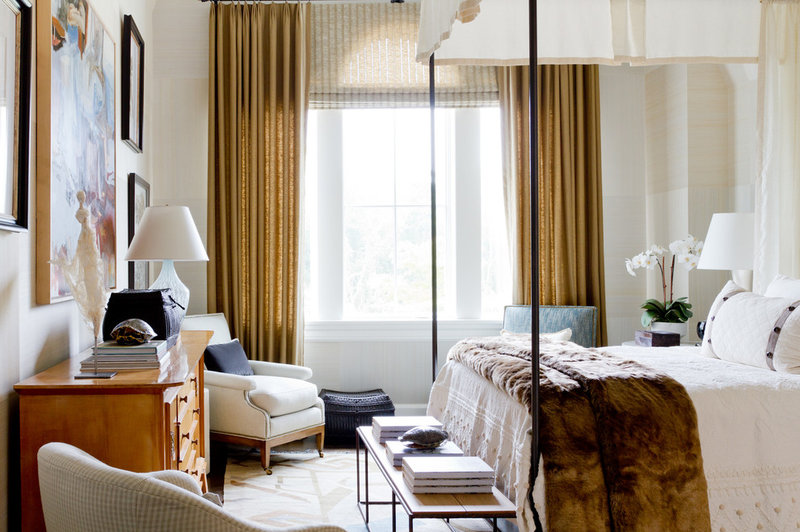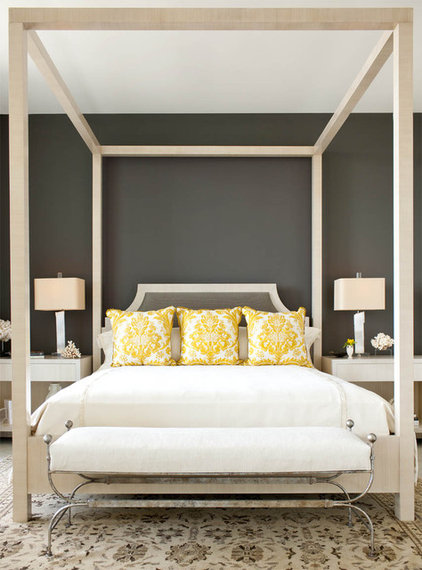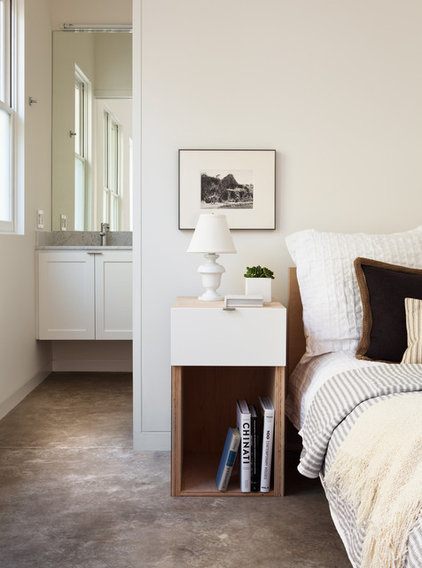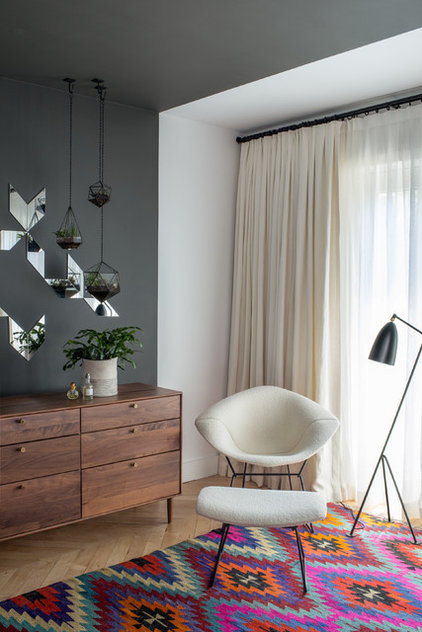Have you been putting off finishing your bedroom? Had it with procrastination, and just need a push to get the decorating job done? Then you’ve come to the right place. The following 14 steps will walk you through the decorating process from start to finish, leaving no detail overlooked. Let’s get started.
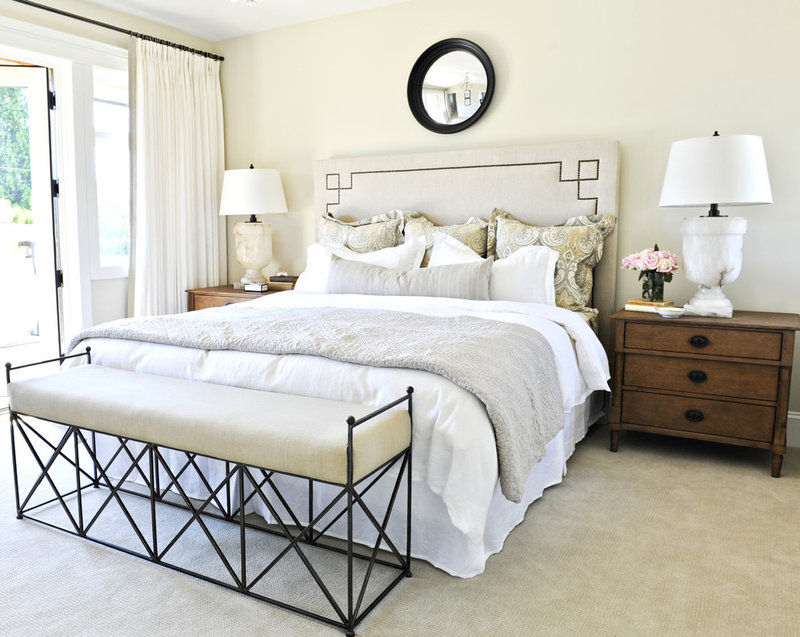
1. Find inspiration. This is the time to save favorite images from Houzz, blogs and magazines for bedroom inspiration. Sift through your collection and choose two or three images that together best represent the look and feel you want to create in your bedroom. Once you have your inspiration images, make a list of all of the elements you like about the photos. Try to move beyond “mood” words (“serene,” “fresh” etc.) and nail down specific furniture styles, colors and accessories that you want in your space. Using the room shown here as an example, you might list:
- Upholstered headboard
- Nailhead trim
- Chests as nightstands
- Marble
- Creamy tones and black accents
- Round mirror
- Bench at foot of bed
List each detail separately: “nailhead trim” and “upholstered headboard” each get a separate line. The reason: If you get too specific, you can get stuck trying to track down one item from your wish list (an upholstered headboard with nailhead trim); this way you can create your own look that still contains your favorite elements.
You might find an upholstered headboard and pick up a bench or chest with nailhead trim, for instance. Or the marble lamps shown in the room here may translate into a marble-topped dresser in your finished room. Browse thousands of bedroom photos by style
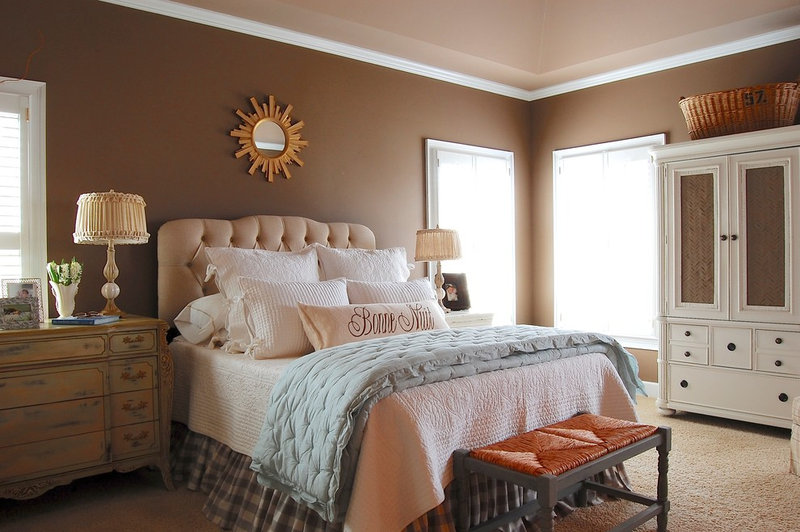
2. Paint or paper the walls. It’s important not to get too wrapped up in the inspiration phase of your project — you may never really get started! Get a jump on things by choosing your wall treatments early in the process. Another reason it’s a good idea to paint or paper early on is it will give you a chance to live with the colors and tweak if necessary. Plus, going to all the trouble of painting is usually a great motivator to get the rest of the work done.
3. Decide what to keep, what to revamp and what to buy. Most of us cannot feasibly go out and completely redecorate a room in one go, and you may not want to anyway. Try to look at each item in your bedroom with fresh eyes (sometimes taking photos helps) and decide what you can work into the new scheme. Some pieces can be used as is; others may be moved (for example, use an old dresser as a nightstand); and some pieces you may want to alter (repaint an armoire and line the glass doors with burlap). Once you have your list of keepers, make a fresh list of what you still need, including supplies for refurbishing your old stuff. And don’t forget, you can always
shop other rooms in your house, too.
4. Take measurements and create a furniture plan. Measure the length and width of your room, the distance between windows (that is, available wall space) and the windows themselves. From your measurements decide what size pieces will comfortably fit in your room. If you were thinking of getting a king-size bed, but a queen would give you more room for a dresser and sitting area, now is the time to make the call about what is most important to you.
Plug your measurements into an online tool (search for “free floor plan tool”) or make a sketch on paper and play around with potential furniture arrangements. It’s much easier to move or swap out furniture on paper or onscreen than in real life — so do some virtual lifting before you plunk your money down on new stuff.
5. Choose a bed. If you are buying a new bed, you probably already have a pretty good idea of the kind you want, but if not, it’s time to make a decision. Four-posters and canopies are quite tall, so be sure to measure your ceilings before committing to one — you should have well over a foot of clearance.
If you like to read in bed, consider an upholstered headboard or a wood headboard with an ergonomic shape. Try to see the bed you want in person before buying it. If that’s not possible, at least be sure to check the return policy in advance.
6. Track down the right-height nightstands. It’s important not to choose your nightstands before your bed, because the height of the nightstands will depend on the height of your bed, including the mattresses. The ideal nightstand height for most people is mattress height or a few inches higher. The tabletop should be no lower than your mattress, but up to 6 inches higher can work. The reason: It’s easier to reach up than to reach down when you are in bed.
In a tiny space, hang a shelf or bracket on the wall, a few inches above the level of the mattress.
7. Choose or revamp a dresser. Look for a dresser that complements your bed but is not identical in style. If you have the space, get a long, low dresser; it will provide lots of display space, and it won’t tower over the bed. If you move frequently, consider a tallboy style, since it will fit into more spaces. If you plan to revamp an existing dresser, look at potential paint colors and finishes, and choose new hardware if desired. Mark a calendar date for working on your project.
8. Add lighting. For bedside lamps you can’t go wrong with a matched pair. If floor space is tight, look into sconces — plug-in sconces with cord covers are a good solution for renters. Bedside lamps are essential, but a room really needs at least three light sources to feel well lit. Add a pendant light overhead or wind fairy lights over the top of a canopy or four-poster for extra glow. Overhead lights in the bedroom should be on dimmers; bedside lamps should have dimmers or three-way bulbs.



